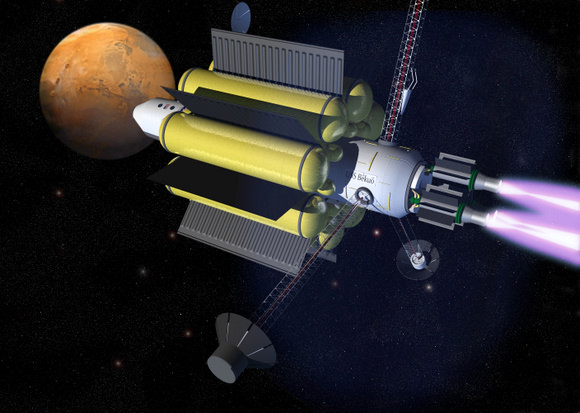[/caption]
A next-generation plasma rocket being developed by former NASA astronaut Franklin Chang Diaz called the Variable Specific Impulse Magnetoplasma Rocket (VASIMR) has been touted as a way to get astronauts to Mars in weeks rather than months, as well as an innovative, cheap way to re-boost the International Space Station. But in a biting commentary posted on Space News and the Mars Society website, “Mars Direct” advocate Robert Zubrin calls VASIMR a “hoax” saying the engine “is neither revolutionary nor particularly promising. Rather, it is just another addition to the family of electric thrusters, which convert electric power to jet thrust, but are markedly inferior to the ones we already have,” adding, “There is thus no basis whatsoever for believing in the feasibility of Chang Diaz’s fantasy power system.”
The VASIMR uses plasma as a propellant. A gas is ionized using radio waves entering into a plasma state. As ions the plasma can be directed and accelerated by a magnetic field to create specific thrust. The purported advantage of the VASIMR lies in its ability to change from high impulse to low impulse thrust as needed, making it an ideal candidate for a mission beyond low Earth orbit.
Chang Diaz’ company, the Ad Astra Rocket Company successfully tested the VASIMR VX-200 plasma engine in 2009. It ran at 201 kilowatts in a vacuum chamber, passing the 200-kilowatt mark for the first time. “It’s the most powerful plasma rocket in the world right now,” said Chang-Diaz at the time. Ad Astra has signed a Space Act agreement with NASA to test a 200-kilowatt VASIMR engine on the International Space Station, reportedly in 2013.
The tests would provide periodic boosts to the space station, which gradually drops in altitude due to atmospheric drag. ISS boosts are currently provided by spacecraft with conventional thrusters, which consume about 7.5 tons of propellant per year. By cutting this amount down to 0.3 tons, Chang-Diaz estimates that VASIMR could save NASA millions of dollars per year.
For the engine to enable trips to Mars in a reported 39 days, a 10- to 20-megawatt VASIMR engine ion engine would need to be coupled with nuclear power to dramatically shorten human transit times between planets.

Zubrin is the president of the Mars Society and author of the book “The Case for Mars: The Plan to Settle the Red Planet and Why We Must.” He has long touted the “Mars Direct” approach of getting humans to Mars to create a sustainable human settlement. The plan includes a series of unmanned and human flights to Mars using existing technology, as well as “living off the land” on Mars by creating rocket fuel to return to Earth, and using underground reservoirs of water on Mars.
In his commentary on VASIMR, Zubrin says, “existing ion thrusters routinely achieve 70 percent efficiency and have operated successfully both on the test stand and in space for thousands of hours. In contrast, after 30 years of research, the VASIMR has only obtained about 50 percent efficiency in test stand burns of a few seconds’ duration.”
On the ‘39 days to Mars’ claim, Zubrin says VASIMR would need to couple with a nuclear reactor system with a power of 200,000 kilowatts and a power-to-mass ratio of 1,000 watts per kilogram, while the largest space nuclear reactor ever built, the Soviet Topaz, had a power of 10 kilowatts and a power-to-mass ratio of 10 watts per kilogram.
Zubrin has invited Chang Diaz to a formal public debate the VASIMR at a Mars Society convention in Dallas next month.
Read Zubrin’s commentary on Space News or the Mars Society website.
More info: Ad Astra Rocket Company

